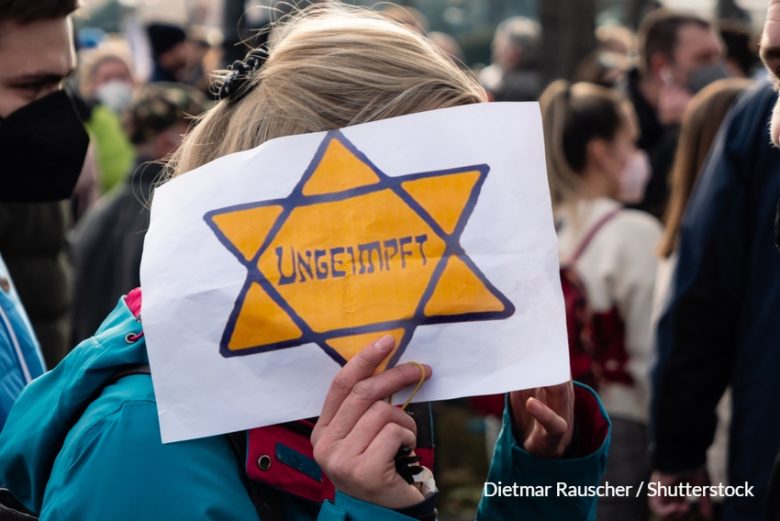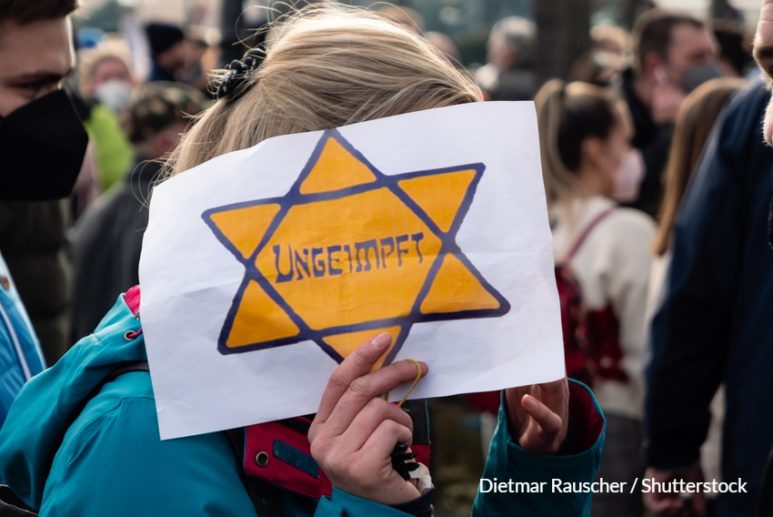This article was first published on Get The Trolls Out!
By Aniko Felix
It has been seventy-eight years after the Holocaust, and while some of the survivors are still with us to tell their stories, more and newer forms of Holocaust denial and distortion appear globally. Although Holocaust denial is not a new phenomenon, recent instances share common traits with past examples and narratives. For example, they always adjust to current challenges in order to become attractive to a certain audience. It is certainly positive that in recent years cases of Holocaust denial have decreased, however, what is called Holocaust distortion is on the rise.

According to the former International Holocaust Rememberance Alliance (IHRA) Chair Ambassador Michaela Küchler:
“Distortion of the Holocaust is found in all kinds of places. From facts twisted on the internet, to opportunistic statements by politicians, misleading exhibitions at museums, and claims, like that of the founder of Extinction Rebellion, Roger Hallam, who referred to the Holocaust as ‘just another f***ery in human history.’ Each of these forms must be challenged, and strategies for countering them must be developed, for societies and individuals to fulfill their responsibility to commemorate the victims”.
The most recent cases of Holocaust distortion are related to the global COVID-19 pandemic. Some examples include the presence of the Star of David in anti-vax protests or claims and comparisons to medical experiments that took place in concentration camps. In anti-vaccination protests throughout Europe, protestors were seen wearing the Star of David in order to compare the ’stigmatization’ of the unvaccinated to those of Jewish origin who were forced to wear the sign during WWII. Another example is the claim that the unvaccinated will be sent to concentration camps.
Those two examples are just two antisemitic narratives that are being used in anti-vax movements which insult the memory of the victims and relativise their suffering. A recent report led by Media Diversity Institute as part of the Get The Trolls Out! project found that antisemitic narratives are widespread on social media in several European countries. One of the most concerning elements of the use of the Holocaust as a comparison to the COVID-19 vaccine is the fact that the antisemitic nature of this comparison, as well as the reasons why it hurts the survivors, are not clear by many. Such incidents also show the conspiratorial nature of the anti-vax movements. Conspiratorial antisemitism is a core part of the anti-vax discourse: the background power, the Bilderberg group or the New World Order are just different versions of the same old theme: the Jews who are behind every threat aiming to destroy ‘our’ group of people. However, by only banning or muting the anti-vax discourse, those who believe in them can feel more entitled to identify themselves as victims or even worse: to take revenge.
We have to face the fact that many people are still not aware that, apart from spreading hate, such acts also distort historical facts. However, one could say that the Holocaust and the pandemic have something in common: the distortion of facts due to misinformation and disinformation. Therefore on the one hand it is obviously very crucial to increase the general knowledge about the history of the Holocaust, and try to reduce biased thinking. But in order to understand these processes we have to approach them from a different perspective. We need to understand what type of needs these false victimhood narratives fulfill and what types of answers we can give to that.
We are living in historic times where our capacity for solidarity and for compassion is greatly challenged, our ability to see things in their complexity is tested. The pandemic is a global threat to all of us, and we have to admit that a certain level of uncertainty has become our everyday experience. These days it is tempting to identify ourselves as incapable victims of the circumstances whose ability to act and to be informed is completely taken awayby someone else who is responsible for everything that is wrong. Those who create and spread these narratives are aware of it. And at this point we have to differentiate between those who consciously spread these narratives and those groups of people who consume them, noting the possible overlap between the two. Those who are on the ‘edges’, the extremists and those who consciously manipulate people with false information, have to be stopped. To prevent the spread of misinformation and disinformation about the pandemic can save lives. Both in a way that can help to reduce those who believe that COVID-19 is just a ‘hoax’ or it is ‘not that serious’ or the lives of those who are potentially endangered as the target of the related conspiracy myths. At the same time there should be a parallel strategy for fighting conspiratorial antisemitic narratives.
Instead of ’othering’ those who believe in conspiracies and are part of those movements we need to find a different way to reach out to those who are not yet on the political extreme edge of the society. In order to do that, the strategies we use should not be populist, as populism strengthens their possible insecurities and divides the society.
Insecurity increases the need for belonging: online platforms and related groups are not only means for spreading these theories but they also offer a sense of togetherness. So the responses have to focus on this need too. By creating networks with a group identity that is not based on exclusion but on reflection of real needs can decrease people’s vulnerability to dangerous theories. Feelings of insecurity can be reduced with affirmative alternative narratives that seek to identify the common parts, experiences of our past and present and our common future goals. The global pandemic could be an opportunity to realise that we have a lot in common.
Those in the public eye, including journalists and researchers, have a great responsibility on the way they talk about the “ordinary” people and how they interpret their motivations. I dedicated my research to understanding the motivation of those who join far-right groups. This is inevitably connected to my Jewish origin and the horrible experience my ancestors had to go through during the Holocaust. I feel that it is obligatory to give a real understanding of why people can be turned to political extremist sides. This is what we owe to the people who were murdered during the Holocaust.
Photo Credit: Dietmar Rauscher / Shutterstock

